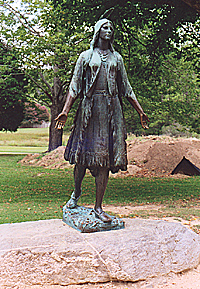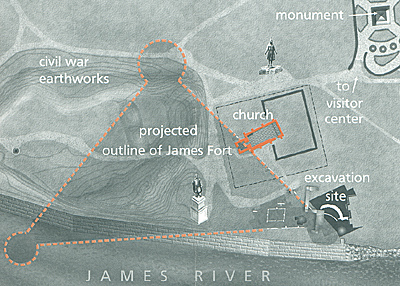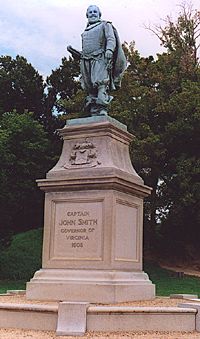 As the ranger tour was just leaving, we headed out the back and onto the patio, walking around the 1907 obelisk called the Tercentary Monument. The ranger pretty much noted must of the history contained in the film, although adding details and anecdotes I can't remember. It was a pleasant enough talk and walk, as most ranger tours are. As far as I'm concerned, National Park sites always provide an entertaining visit--it might be a historical site like Jamestown or a battlefield, or a natural site like Yosemite.
As the ranger tour was just leaving, we headed out the back and onto the patio, walking around the 1907 obelisk called the Tercentary Monument. The ranger pretty much noted must of the history contained in the film, although adding details and anecdotes I can't remember. It was a pleasant enough talk and walk, as most ranger tours are. As far as I'm concerned, National Park sites always provide an entertaining visit--it might be a historical site like Jamestown or a battlefield, or a natural site like Yosemite.
The group walked to the right and through a gate next to the Memorial Church, also built in 1907. In a small courtyard, a 1922 statue of Pocahontas stands with open arms in full Hollywood garb. The ranger brought along period drawings made by a Englishman that showed Pocahontas looking more like a scantily clad Britney Spears than the Disney version. Although she has suffered the neglect of time with a dulling patina, the hands are touched by so many visitors, they shine.
A little way onward, an archeological dig was ongoing at the entryway of the Church. It's not exactly Indiana Jones. At the time, the two diggers were digging with small implements. I did not hear a shout of "Eureka" or such. Maybe it was slow day.
 The current standing church was built in 1907 over the foundations of the 1639 brick church, which was built over the original 1617 wood frame church. It was in the wood frame church where the first political assembly met in 1619.
The current standing church was built in 1907 over the foundations of the 1639 brick church, which was built over the original 1617 wood frame church. It was in the wood frame church where the first political assembly met in 1619.
Next to the church is the clock tower, the only 17th century structure still standing. It's not all that impressive, mostly because everyone concentrated on the diggers.
The group moved under the speading arms of an oak tree, the ranger rattling off a variety of celebrities who visited, presidents, Queen Elizabeth II, and so on. Here, she pointed out a number of sticks stuck into the ground towards the water. This represents the walls of the fort. White stones embedded in the ground mark the outline of the entire fort. Sadly, erosion over the last 400 years ate away at the bank such that one point in the triangular fort is lost underwater. A seawall was built to stabilize the site.
 A statue of John Smith, erected 1907 and dedicated 1908, stands mighty close to the water, so much so I can imagine a tourist falling into the water trying to get a nice shot of the captain. Thankfully, no railings obscure the pleasing slope of the bank.
A statue of John Smith, erected 1907 and dedicated 1908, stands mighty close to the water, so much so I can imagine a tourist falling into the water trying to get a nice shot of the captain. Thankfully, no railings obscure the pleasing slope of the bank.
The group continued to the last stop on the edge of the "Old Towne." As poor a site as it was in the 1600s, in the intervening 400 years plenty of generations moved in. Old Towne refers to the 1620s town, while New Towne refers to post 1700s as the colonists expanded the town eastward.
More Colonial Williamsburg
- Introduction and Colony History
Visitor's Center
Old Town
New Town
Five Mile Loop
Jumbo Illustration of 1600s Jamestown (monstrously slow: 1.3Mb)
Back to List of Historic Sites
Back to Travel Master List
Back to MagWeb Master List of Magazines
© Copyright 2003 by Coalition Web, Inc.
This article appears in MagWeb (Magazine Web) on the Internet World Wide Web.
Other articles covering military history and related topics are available at http://www.magweb.com